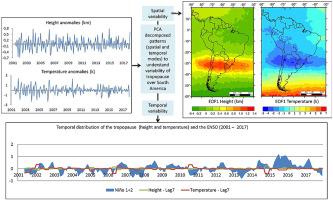当前位置:
X-MOL 学术
›
J. Atmos. Sol. Terr. Phys.
›
论文详情
Our official English website, www.x-mol.net, welcomes your
feedback! (Note: you will need to create a separate account there.)
South America's tropopause variability in relation to global teleconnection (2001–2017): A GNSS-radio occultation assessment
Journal of Atmospheric and Solar-Terrestrial Physics ( IF 1.8 ) Pub Date : 2020-11-01 , DOI: 10.1016/j.jastp.2020.105379 A.A. Nascimento , J.L. Awange , R.M. Gonçalves , Khandu
Journal of Atmospheric and Solar-Terrestrial Physics ( IF 1.8 ) Pub Date : 2020-11-01 , DOI: 10.1016/j.jastp.2020.105379 A.A. Nascimento , J.L. Awange , R.M. Gonçalves , Khandu

|
Abstract Analysing tropopause variability is widely acknowledged to inform the understanding of global/regional warming. Tropopause variability studies are generally undertaken where radiosonde data abound. For the radiosonde data deficient South American continent, taking advantage of atmospheric remote sensing using Global Navigation Satellite Systems - Radio Occultation (GNSS-RO) could offer the means to understand its tropopause variability. In this study, 622,914 GNSS-RO measurements of Challenging Minisatellite Payload (CHAMP), Gravity Recovery and Climate Experiment (GRACE) and Constellation Observing System for Meteorology Ionosphere & Climate (FORMOSAT-3/COSMIC), from 2001 to 2017 are used to analyze the annual variability patterns of tropopause heights and temperatures over South America and its relation to global teleconnections. Firstly, the RO measurements are validated using atmospheric profiles for 54 radiosonde stations across the continent. The results show increased trend of 13.450 ± 39.577 m/dec for the tropopause height and a corresponding slow decrease in temperature of −0.021 ± 0.115 K/dec, both statistically insignificant (i.e., p-value test) at 95% of confidence level (two-tailed student's t-test). The first mode of PCA (Principal Component Analysis) of the tropopause anomalies (of temperatures and heights) present significant temporal correlation (at 95% confidence level) with the ENSO 1 + 2 (El Nino–Southern Oscillation) index (i.e., a correlation coefficient of 0.6). The South America tropopause, therefore, varies over time albeit with slow changes and trends. This contribution highlights the importance of its monitoring.
中文翻译:

与全球遥相关的南美洲对流层顶变异(2001-2017):GNSS 无线电掩星评估
摘要 分析对流层顶变异被广泛认为有助于了解全球/区域变暖。对流层顶变异性研究通常在无线电探空仪数据丰富的地方进行。对于无线电探空仪数据不足的南美洲大陆,利用全球导航卫星系统 - 无线电掩星 (GNSS-RO) 的大气遥感可以提供了解其对流层顶变异性的手段。在这项研究中,2001 年至 2017 年对具有挑战性的小卫星有效载荷 (CHAMP)、重力恢复和气候实验 (GRACE) 以及气象电离层和气候星座观测系统 (FORMOSAT-3/COSMIC) 的 622,914 次 GNSS-RO 测量用于分析南美洲对流层顶高度和温度的年度变化模式及其与全球遥相关的关系。首先,使用整个大陆 54 个无线电探空站的大气剖面验证 RO 测量值。结果显示对流层顶高度的增加趋势为 13.450 ± 39.577 m/dec,温度相应缓慢下降 -0.021 ± 0.115 K/dec,在 95% 的置信水平下均不显着(即 p 值检验)(双尾学生 t 检验)。对流层顶异常(温度和高度)的 PCA(主成分分析)的第一种模式与 ENSO 1 + 2(厄尔尼诺-南方涛动)指数(即相关性)呈现显着的时间相关性(置信度为 95%) 0.6 的系数)。因此,尽管变化和趋势缓慢,但南美洲对流层顶会随着时间而变化。这一贡献突出了其监测的重要性。RO 测量使用整个大陆 54 个无线电探空站的大气剖面进行验证。结果显示对流层顶高度的增加趋势为 13.450 ± 39.577 m/dec,温度相应缓慢下降 -0.021 ± 0.115 K/dec,在 95% 的置信水平下均不显着(即 p 值检验)(双尾学生 t 检验)。对流层顶异常(温度和高度)的 PCA(主成分分析)的第一种模式与 ENSO 1 + 2(厄尔尼诺-南方涛动)指数(即相关性)呈现显着的时间相关性(置信度为 95%) 0.6 的系数)。因此,尽管变化和趋势缓慢,但南美洲对流层顶会随着时间而变化。这一贡献突出了其监测的重要性。RO 测量使用整个大陆 54 个无线电探空站的大气剖面进行验证。结果显示对流层顶高度的增加趋势为 13.450 ± 39.577 m/dec,温度相应缓慢下降 -0.021 ± 0.115 K/dec,在 95% 的置信水平下均不显着(即 p 值检验)(双尾学生 t 检验)。对流层顶异常(温度和高度)的 PCA(主成分分析)的第一种模式与 ENSO 1 + 2(厄尔尼诺-南方涛动)指数(即相关性)呈现显着的时间相关性(置信度为 95%) 0.6 的系数)。因此,尽管变化和趋势缓慢,但南美洲对流层顶会随着时间而变化。这一贡献突出了其监测的重要性。
更新日期:2020-11-01
中文翻译:

与全球遥相关的南美洲对流层顶变异(2001-2017):GNSS 无线电掩星评估
摘要 分析对流层顶变异被广泛认为有助于了解全球/区域变暖。对流层顶变异性研究通常在无线电探空仪数据丰富的地方进行。对于无线电探空仪数据不足的南美洲大陆,利用全球导航卫星系统 - 无线电掩星 (GNSS-RO) 的大气遥感可以提供了解其对流层顶变异性的手段。在这项研究中,2001 年至 2017 年对具有挑战性的小卫星有效载荷 (CHAMP)、重力恢复和气候实验 (GRACE) 以及气象电离层和气候星座观测系统 (FORMOSAT-3/COSMIC) 的 622,914 次 GNSS-RO 测量用于分析南美洲对流层顶高度和温度的年度变化模式及其与全球遥相关的关系。首先,使用整个大陆 54 个无线电探空站的大气剖面验证 RO 测量值。结果显示对流层顶高度的增加趋势为 13.450 ± 39.577 m/dec,温度相应缓慢下降 -0.021 ± 0.115 K/dec,在 95% 的置信水平下均不显着(即 p 值检验)(双尾学生 t 检验)。对流层顶异常(温度和高度)的 PCA(主成分分析)的第一种模式与 ENSO 1 + 2(厄尔尼诺-南方涛动)指数(即相关性)呈现显着的时间相关性(置信度为 95%) 0.6 的系数)。因此,尽管变化和趋势缓慢,但南美洲对流层顶会随着时间而变化。这一贡献突出了其监测的重要性。RO 测量使用整个大陆 54 个无线电探空站的大气剖面进行验证。结果显示对流层顶高度的增加趋势为 13.450 ± 39.577 m/dec,温度相应缓慢下降 -0.021 ± 0.115 K/dec,在 95% 的置信水平下均不显着(即 p 值检验)(双尾学生 t 检验)。对流层顶异常(温度和高度)的 PCA(主成分分析)的第一种模式与 ENSO 1 + 2(厄尔尼诺-南方涛动)指数(即相关性)呈现显着的时间相关性(置信度为 95%) 0.6 的系数)。因此,尽管变化和趋势缓慢,但南美洲对流层顶会随着时间而变化。这一贡献突出了其监测的重要性。RO 测量使用整个大陆 54 个无线电探空站的大气剖面进行验证。结果显示对流层顶高度的增加趋势为 13.450 ± 39.577 m/dec,温度相应缓慢下降 -0.021 ± 0.115 K/dec,在 95% 的置信水平下均不显着(即 p 值检验)(双尾学生 t 检验)。对流层顶异常(温度和高度)的 PCA(主成分分析)的第一种模式与 ENSO 1 + 2(厄尔尼诺-南方涛动)指数(即相关性)呈现显着的时间相关性(置信度为 95%) 0.6 的系数)。因此,尽管变化和趋势缓慢,但南美洲对流层顶会随着时间而变化。这一贡献突出了其监测的重要性。











































 京公网安备 11010802027423号
京公网安备 11010802027423号